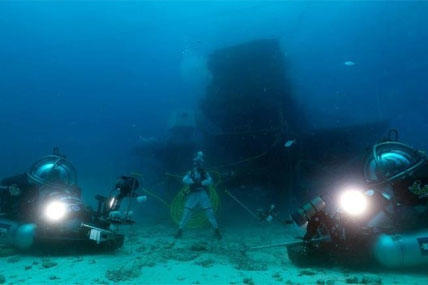A crew of aquanauts – yes aquanauts! – left surface life and submerged themselves in the world’s only undersea laboratory, Aquarius, for two weeks. They were participating in NEEMO 16, a mission designed to help mold future space missions.
Aquarius, operated by the National Oceanic and Atmospheric Administration, allows aquanauts and astronauts alike to conduct research and simulate mission activities in the water’s low gravity. Diving in an underwater laboratory necessitates a unique expertise. It requires plenty of knowledge about underwater operations and skills held by very few individuals. It was just the kind of job for a Coast Guard diver.
Coast Guard divers go through dive school at the Naval Dive and Salvage Training Center in Panama City, Fla. The curriculum student divers are taught over the course of four months focuses on marine engineering and underwater construction as well as salvage skills. The Coast Guard also specializes in SCUBA operations, providing high mobility for dive operations.
The joint operation included partners from NOAA, NASA, European Space Agency, Japan Aerospace Exploration Agency and the U.S. Navy. Due to their specialized training, Coast Guard divers participating in the joint operations were utilized in various capacities.
“Working with NASA and NOAA was enlightening. Being able to work with future astronauts, NOAA dive team members and Navy divers was a great opportunity. From running the supplies needed to live in the Aquarius Habitat, to tending the umbilicals of the astronauts as they practiced their mission, all I can say is it was an awesome mission to be a part of,” said Petty Officer 2nd Class Jason Fields.
The Coast Guard’s divers acted as support crew for the mission completing 28 dives accumulating more than 800 minutes of bottom time. The divers tended the aquanauts in water to simulate weightlessness in space, so the aquanauts could conduct effective and realistic tests. Coast Guard divers also ran supplies back and forth from the surface to the Aquarius underwater lab and assisted in the operation of submersibles.
When not directly supporting the aquanauts they were actively supporting other divers as deck hand support and standing by ready to deploy if a mishap occurred.
Fields and another diver, Petty Officer 2nd Class David Bradbury, know a lot about the importance of staying vigilant in the event of any dive emergencies. Both Fields and Bradbury are safety divers for the new underwater egress facility – more commonly known as the dunker – at Aviation Technical Training Center Elizabeth City.
Their diving proficiency, focusing on safety and procedure, enables aviators from the Coast Guard, Navy and Marine Corps, to learn how to egress, or exit, their aircraft in the event of an emergency. They were able to use these same skills on the joint mission, but applied them to an open water environment. While they shared best practices from their routine dives, they also learned from their fellow divers from partner agencies.
“It was a good training tool and it was also a once in a life time opportunity,” said Petty Officer 2nd Class David Bradbury. “We dove, worked and lived with amazing people. The overall thankfulness of the NASA, NOAA and Aquarius reef base team was heartfelt. I am thankful for the opportunity that I had and am looking forward to do it again.”
From instructing the service’s future aviators, to supporting aquanauts in their research for space, there is no shortage of expertise Coast Guard divers bring to the table… or underwater laboratory.





























